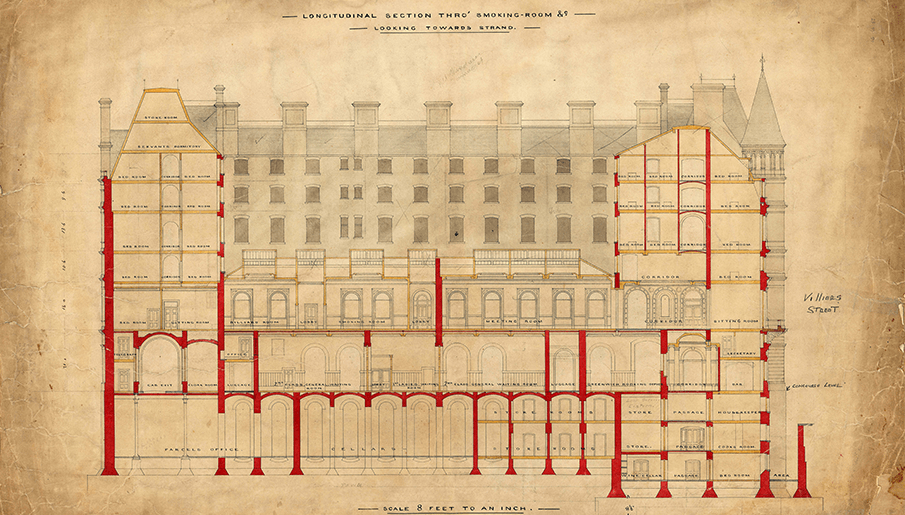The history of Charing Cross station
Charing Cross is London’s most central terminus.
The South Eastern Railway already had a presence at London Bridge station, however the Company soon realised that a large number of its passengers from the developing southern commuter belt needed to continue their journeys to the City and the West End.

Plans were made to extend their line from the station at London Bridge to the centre of the Capital, to tap into this growing and lucrative commuter market.
The railway is authorised
Authorisation to build the Charing Cross Railway was given by Parliament in August 1859. This would extend the South Eastern Railway’s line from London Bridge over the River Thames and into a terminus located between Waterloo Bridge and Westminster Bridge. This area of London was already crowded and the site chosen was difficult.
The station was to be built on the site of Hungerford Market; having operated since the 17th century and only recently extended, the market had to be demolished. The station plans also required the relocation of St Thomas’ Hospital and the re-internment of bodies from the old College Burial Ground of St Mary, Lambeth.
After lengthy negotiations regarding the chosen site, work started on the station in 1862. The station was designed by Sir John Hawkshaw with 6 terminus platforms and a large single span trussed arched train shed roof which was 164ft wide and 510ft long.
It initially opened to traffic on 11 January 1864 and quickly became a busy station for both commuter and continental departures, having a direct link into London Bridge station and onwards to Folkestone and Dover.
The station frontage was provided by the elegant Charing Cross Hotel, designed by Edward Middleton Barry in the French Renaissance style. The hotel soon became one of the most fashionable hotels in London; accommodation and refreshment was provided for travellers making use of direct services from the City and West End to the south coast, where they could make their onward travel to the continent.
The Hungerford Bridge
Along with the station, Sir John Hawkshaw also designed the Hungerford Bridge which carried the railway over the River Thames and into Charing Cross. In 1845 Isambard Kingdom Brunel had built a suspension bridge over the Thames at the same spot, which now had to be demolished for the new railway bridge to be built.
Two piers from Brunel’s bridge were used in the new railway bridge and the suspension chains reused in the Clifton Bridge at Bristol. Contemporary with Charing Cross the Clifton Suspension Bridge was being built as a memorial to Brunel with Sir John Hawkshaw and William Henry Barlow as consultant engineers.
The Hungerford Bridge originally had 4 tracks and two footpaths on either side of the line. However one of the footpaths was later utilised to widen the bridge to 6 tracks to create more capacity on the approach to the station. Somewhat utilitarian for the tastes of the time, the Hungerford Bridge was criticised as being a dreary crossing across the river, a reputation it held onto until recently.
In 2002 the Hungerford Bridge Millennium Project designed and built new independent footbridges either side of the railway, transforming the look and feel of the original by suspending the walkways using steel pylons and cables.
Disaster strikes
In 1905 when work was being undertaken on Hawkshaw’s arched trainshed roof, a wrought iron tie rod snapped which caused a significant section of the roof to collapse and a wall to fall onto the adjacent Avenue Theatre. While there was time to clear the scene and suspend train services from the station, 6 people died in the accident.
What was left of the vaulted roof was taken down; as the subsequent enquiry raised questions about the original design and construction, the decision was taken to replace it with a flat ridge and furrow roof in 1906.
Charing Cross played an important role during the First World War as one of the main departure points for troops and supplies leaving for the western front. At this time the South Eastern and Chatham Railway (as the South Eastern Railway had become) also chose to concentrate its continental services at Victoria Station and the facilities for the overseas traveller, including the foreign language signs, were removed from Charing Cross.
Air Space
In the 1980s the station was redeveloped and the air space above the platforms used for new office accommodation. Designed by Terry Farrell, Embankment Place rests on a concrete raft put in place of the 1906 roof.
The building has no supporting columns projecting into the station which allows the space to keep a sense of openness and light. Viewed from the river, Embankment Place gives the impression of Victorian trainshed roofs rising from the banks of the Thames.
Today, Charing Cross is still a busy commuter station, handling over 37 million people every year.
Did you know?
The Hungerford Bridge is the subject of a painting by Claude Monet.